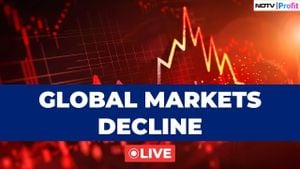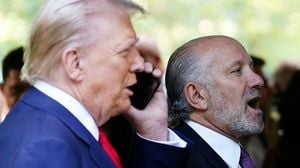The 2024 U.S. presidential election marks a pivotal moment, not just for Americans, but also for the global economic stage. The candidates, Vice President Kamala Harris and former President Donald Trump, present two contrasting visions for the country's future, and according to various experts, the economic repercussions of their policies could resonate far beyond U.S. borders.
With the election drawing near, Europe's economy finds itself caught between these two figures, each potentially steering the ship toward different waters. For many European leaders, the upcoming elections offer what they describe as the "least bad" choice: either re-electing Trump, who might reignite trade wars and upend alliances, or accepting Harris, who proponents say would simply continue the business-as-usual approach established during Joe Biden's presidency.
Looking at trade policies, there's little optimism on either side from Europe. Under Harris, insights suggest minimal shifts from current strategies, which means no significant favors as far as transatlantic relations go. Analysts like Zach Meyers from the Centre for European Reform express concerns, stating, "Both U.S. candidates have the same direction of travel – Trump less predictable and perhaps willing to be more confrontational with the European Union."
If Trump secures another term, the stakes intensify dramatically. There's fear of him retracting U.S. support for Ukraine, forcing European governments to dramatically bolster their defense spending. This includes the need for faster reinforcements of security budgets, particularly if he resumes tariffs on imported goods from Europe, which could ramp up to as high as 20%. Just think of the Spanish olive industry, which has watched its exports plummet by 70% since Trump first imposed tariffs back in 2018. Antonio de Mora, head of the olive exporters' association, voiced his worries about what Trump's re-election could mean for their livelihoods, saying, "This could get worse, and we think it will be difficult to resolve this without pressure from Europe."
Economists predict significant downsides for Europe no matter who wins. A recent analysis suggested Trump's potential tariffs could reduce economic output by one percentage point across the Eurozone. Goldman Sachs analysts warn any economic benefits from increased defense spending could be dwarfed by geopolitical risks and trade uncertainties stemming from the election results. While Harris's presidency might not introduce drastic changes in the short term, it could afford EU nations some time before they have to prepare for uncertainty or conflicts.
Meanwhile, on the other side of the political spectrum, Trump and Harris are trading barbs over their economic platforms. Trump's team is adamantly criticizing Harris's plans as insufficient, particularly her "opportunity agenda" for Black men, with Trump's campaign questioning her commitment to significant economic reforms.
According to the Committee for a Responsible Federal Budget (CRFB), Trump's fiscal proposals risk growing the federal debt by as much as $7.5 trillion over the next decade—all versus Harris's plans expected to contribute $3.5 trillion. This stark difference lays bare the fundamentals of the debate, but it’s important to dissect these figures more critically.
The crux of the matter is not merely the ballooning figures projected by the CRFB but the qualitative impacts of such policies. Harris aims to continue government services to all demographics, especially those struggling economically, which could bolster long-term growth. Trump, on the other hand, prioritizes tax cuts and increased tariffs—moves many economists argue would harm lower and middle-income consumers more than they would help them.
Addressing tariffs, Trump has made it clear he envisions imposing hefty levies on imports, especially from China, which could generate substantial revenue (projected at $3.7 trillion over the decade). Yet, the consensus among economists is this same policy risks inflaming prices for consumers and inciting retaliatory measures from other countries, including our closest trading partners.
Economic analysts, like those from the CRFB, have tried to address these scenarios, but their findings suggest they're often painting with too broad of strokes. The CRFB’s estimates include confusing ranges and questionable assumptions about trade impacts. For example, its analysis determined Trump's aggressive trade policies might generate revenue but fails to truly capture how tariffs function as taxes on consumers.
“In essence, tariffs hurt U.S. households,” noted one commentator, emphasizing the error in viewing tariff revenue as simply advantageous. When you dig beneath the surface, many households could see significant increases to their day-to-day existence as resulting costs trickle down.
To connect these dots, let’s take manufacturing. Trump believes his tariffs will protect American manufacturing jobs and encourage companies to relocate back to the U.S. Yet, it raises the question: will these firms bear those additional costs without passing them onto consumers? Trump insists they won’t. When questioned about this potential rise, he asserted, “If I implement tariffs, you’ll see car companies returning to the U.S.” But this narrative stands at odds with realities faced by the industry, where the cost of goods produced under supervision of new trade policies may well dictate suppliers’ decisions.
On the flip side, Harris's potential to stabilize the economic environment might not incite as much concern as Trump's unpredictability. But analysts remain skeptical—pointing out the challenges of continuous dependence on existing U.S. trade flows with both China and the EU. Republican advisors caution against the potential for electoral ripple effects if Trump’s agenda were to sway from the typically progressive policies of Biden's governance.
The virulence surrounding immigration policies also looms large. Trump proposes expansive deportation plans which the CRFB warns could inadvertently affect the labor market lifespan of millions of undocumented workers. Previous analysis has shown laying off such workers could hinder growth. A Peterson Institute for International Economics report indicates deportation impacts extend beyond immediate labor reductions. Economists argue reducing labor availability shifts consumer habits and tightens production.
Finally, as America heads to the polls, reactions from both sides of the Atlantic will echo here for months to come. With the election just weeks away, businesses across Europe can only hold their breath as the C-suite personnel brace for the potential fallout from whichever candidate emerges victorious. Trump and Harris, albeit representing different paths, both present palpable risks to the European economy. Whether it’s through tariffs, trade agreements, or immigration impacts, the stakes couldn’t be higher. For countries with closely intertwined economies, the 2024 U.S. presidential election appears poised to shape their futures for years to come.
So, as the U.S. gears up for another intense election season, it's time for leaders around the globe to keep their eyes peeled. No matter what happens, the ramifications of the choices made by American voters are sure to reverberate far and wide, solidifying the importance of this election on the global stage.



